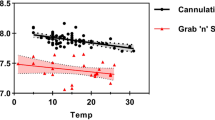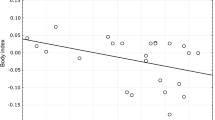Abstract
Body composition is an important parameter in diving animals intermittently fasting on land, such as southern elephant seals, as it is known to impact their time of departure at sea, swimming effort, foraging success, and survival. Deuterium labeled water is commonly used to assess total body water, but a precise indication of equilibration time in this species and reliable sample storage are lacking. We injected newly weaned southern elephant seal female pups with deuterium-labeled water. We thereafter blood sampled the seals several times to assess the equilibration time and body composition. We implemented two storage methods, flame-sealed capillaries and frozen serums stored at − 20 °C in a gas freezer. The frozen serums method was reliable as capillaries and safer to bring undamaged samples from the field. This method of determining body composition in wild animals is reliable and easily applicable for isolated and difficult-to-access fieldwork.


Similar content being viewed by others
Explore related subjects
Discover the latest articles and news from researchers in related subjects, suggested using machine learning.Data availability
The experimental data and the simulation results that support the findings of this study are available in Figshare with the identifier https://doi.org/10.6084/m9.figshare.26809102.
References
Adachi T, Lovell P, Turnbull J et al (2023) Body condition changes at sea: onboard calculation and telemetry of body density in diving animals. Methods Ecol Evol 14:1457–1474. https://doi.org/10.1111/2041-210X.14089
Aoki K, Watanabe Y, Crocker D et al (2011) Northern elephant seals adjust gliding and stroking patterns with changes in buoyancy: validation of at-sea metrics of body density. J Exp Biol 214:2973–2987. https://doi.org/10.1242/jeb.055137
Arnbom T, Fedak MA, Boyd IL, McConnell BJ (1993) Variation in weaning mass of pups in relation to maternal mass, postweaning fast duration, and weaned pup behaviour in southern elephant seals (Mirounga leonina) at South Georgia. Can J Zool 71:1772–1781. https://doi.org/10.1139/z93-252
Arnould JPY, Boyd IL, Speakman JR (1996) Measuring the body composition of antarctic fur seals (Arctocephalus gazella ): validation of hydrogen isotope dilution. Physiol Zool 69:93–116. https://doi.org/10.1086/physzool.69.1.30164202
Bailleul F, Charrassin J-B, Monestiez P et al (2007) Successful foraging zones of southern elephant seals from the Kerguelen Islands in relation to oceanographic conditions. Philos Trans Royal Soc b: Biol Sci 362:2169–2181. https://doi.org/10.1098/rstb.2007.2109
Bennett KA, Speakman JR, Moss SEW et al (2007) Effects of mass and body composition on fasting fuel utilisation in grey seal pups (Halichoerus grypus Fabricius): an experimental study using supplementary feeding. J Exp Biol 210:3043–3053. https://doi.org/10.1242/jeb.009381
Biuw M, McConnell B, Bradshaw CJA et al (2003) Blubber and buoyancy: monitoring the body condition of free-ranging seals using simple dive characteristics. J Exp Biol 206:3405–3423. https://doi.org/10.1242/jeb.00583
Bland JM, Altman DG (1986) Statistical methods for assessing agreement between two methods of clinical measurement. Lancet 1:307–310
Boyd I, Arnbom T, Fedak M (1993) Water flux, body composition, and metabolic rate during molt in female southern elephant seals (Mirounga leonina). Physiol Zool 66:43–60. https://doi.org/10.1086/physzool.66.1.30158286
Carlini AR, Panarello HO, Marquez MEI et al (2000) Energy gain and loss during lactation and postweaning in southern elephant seal pups (Mirounga leonina) at King George Island. Polar Biol 23:437–440. https://doi.org/10.1007/s003000050465
Carlini AR, Márquez MEI, Ramdohr S et al (2001) Postweaning duration and body composition changes in southern elephant seal (Mirounga leonina ) Pups at King George Island. Physiol Biochem Zool 74:531–540. https://doi.org/10.1086/322168
Costa DP, Boeuf BJL, Huntley AC, Ortiz CL (1986) The energetics of lactation in the Northern elephant seal, Mirounga angustirostris. J Zool 209:21–33. https://doi.org/10.1111/j.1469-7998.1986.tb03563.x
Cox SL, Authier M, Orgeret F et al (2020) High mortality rates in a juvenile free-ranging marine predator and links to dive and forage ability. Ecol Evol 10:410–430. https://doi.org/10.1002/ece3.5905
Currie JJ, van Aswegen M, Stack SH et al (2021) Rapid weight loss in free ranging pygmy killer whales (Feresa attenuata) and the implications for anthropogenic disturbance of odontocetes. Sci Rep 11:8181. https://doi.org/10.1038/s41598-021-87514-2
Dunn P, Carter JF (2018) Good Practice Guide for Isotope Ratio Mass Spectrometry Second Edition 2018
Field IC, Bradshaw CJA, Burton HR, Hindell MA (2005) Juvenile Southern elephant seals exhibit seasonal differences in energetic requirements and use of lipids and protein stores. Physiol Biochem Zool 78:491–504. https://doi.org/10.1086/430227
Gales R, Renouf D, Worthy GAJ (1994) Use of bioelectrical impedance analysis to assess body composition of seals. Mar Mamm Sci 10:1–12. https://doi.org/10.1111/j.1748-7692.1994.tb00385.x
Guinet C (1992) Croissance des éléphants de mer de l’archipel Crozet (46°25’ S, 51°45’ E) pendant leur première année de vie. 56:459–468. https://doi.org/10.1515/mamm.1992.56.3.459
Guinet C, Roux JP, Bonnet M, Mison V (1998) Effect of body size, body mass, and body condition on reproduction of female South African fur seals (Arctocephalus pusillus) in Namibia. Can J Zool 76:1418–1424. https://doi.org/10.1139/z98-082
Hindell MA, Burton HR (1988) Seasonal haul-out patterns of the southern elephant seal (Mirounga leonina L.), at Macquarie Island. J Mamm 69:81–88. https://doi.org/10.2307/1381750
Hindell MA, Bryden MM, Burton HR (1994) Early growth and milk-composition in southern elephant seals (Mirounga-Leonina). Aust J Zool 42:723–732. https://doi.org/10.1071/zo9940723
International Atomic Energy Agency (2001) GNIP Maps and Animations. http://isohis.iaea.org. Accessed 20 Aug 2024
Laborie J, Authier M, Chaigne A et al (2023) Estimation of total population size of southern elephant seals (Mirounga leonina) on Kerguelen and Crozet Archipelagos using very high-resolution satellite imagery. Front Mar Sci. https://doi.org/10.3389/fmars.2023.1149100
Le Boeuf BJ, Laws RM (1994) One elephant seals: an introduction to the genus. In: Le Boeuf BJ, Laws RM (eds) Elephant seals. University of California Press, Oakland, pp 1–26
Lee TN, Fridinger RW, Barnes BM et al (2011) Estimating lean mass over a wide range of body composition: a calibration of deuterium dilution in the arctic ground squirrel: isotope dilution calibration for arctic ground squirrels. Rapid Commun Mass Spectrom 25:3491–3496. https://doi.org/10.1002/rcm.5253
Mata AJ, Caloin M, Robin J, Le Maho Y (2006) Reliability in estimates of body composition of birds: oxygen-18 versus deuterium dilution. Physiol Biochem Zool 79:202–209. https://doi.org/10.1086/498354
Mawson D (1934) The Kerguelen Archipelago. Geogr J 83:18–27. https://doi.org/10.2307/1786659
Mcdonald B, Crocker D, Burns J, Costa D (2007) Body condition as an index of winter foraging success in crabeater seals (Lobodon carcinophaga). Deep Sea ResII 55:515–522
Modig A, Engström H, Arnbom T (1997) Postweaning behaviour in pups of the southern elephant seal (Mirounga leonina) on South Georgia. Can J Zool 75:582–588. https://doi.org/10.1139/z97-072
Mota JL, Brown DJ, Canning DM et al (2021) Influence of landscape condition on relative abundance and body condition of two generalist freshwater turtle species. Ecol Evol 11:5511–5521. https://doi.org/10.1002/ece3.7450
Mumby HS, Mar KU, Thitaram C et al (2015) Stress and body condition are associated with climate and demography in Asian elephants. Conserv Physiol 3:cov030. https://doi.org/10.1093/conphys/cov030
Nathan L, Gordon GB, Visscher MB, Nier AO (1949) The fate of utilized molecular oxygen and the source of the oxygen of respiratory carbon dioxide, studied with the aid of heavy oxygen. J Biol Chem 180:803–811. https://doi.org/10.1016/S0021-9258(18)56700-4
Nordøy ES, Stijfhoorn DE, Råheim A, Blix AS (1992) Water flux and early signs of entrance into phase 111 of fasting in grey seal pups. Acta Physiol Scand 144:477–482. https://doi.org/10.1111/j.1748-1716.1992.tb09324.x
Orgeret F, Cox SL, Weimerskirch H, Guinet C (2019) Body condition influences ontogeny of foraging behavior in juvenile southern elephant seals. Ecol Evol 9:223–236. https://doi.org/10.1002/ece3.4717
Reilly JJ, Fedak MA (1990) Measurement of the body composition of living gray seals by hydrogen isotope dilution. J Appl Physiol 69:885–891. https://doi.org/10.1152/jappl.1990.69.3.885
Schoeller DA, Van Santen E, Peterson DW et al (1980) Total body water measurement in humans with 18O and 2H labeled water. Am J Clin Nutr 33:2686–2693. https://doi.org/10.1093/ajcn/33.12.2686
Shero M, Pearson L, Costa D, Burns J (2014) Improving the precision of our ecosystem calipers: a modified morphometric technique for estimating marine mammal mass and body composition. PLoS ONE 9:e91233. https://doi.org/10.1371/journal.pone.0091233
Speakman J (1998) Speakman JR. The history and theory of the doubly labeled water technique. Am J Clin Nutr 68:932S-938S
Steele ZT, Caceres K, Jameson AD et al (2024) A protocol for distilling animal body water from biological samples and measuring oxygen and hydrogen stable isotopes via cavity ring-down spectroscopy. Isotopes Environ Health Stud 60:229–250. https://doi.org/10.1080/10256016.2024.2323201
Stirling I, Lunn NJ, Iacozza J (1999) Long-term Trends in the population ecology of polar bears in Western Hudson Bay in relation to climatic change. ARCTIC 52:294–306. https://doi.org/10.14430/arctic935
Tierney M, Hindell M, Lea M-A, Tollit D (2001) A comparison of techniques used to estimate body condition of southern elephant seals (Mirounga leonina). Wildl Res 28:581. https://doi.org/10.1071/WR00066
Vuarin P, Dammhahn M, Henry P-Y (2013) Individual flexibility in energy saving: body size and condition constrain torpor use. Funct Ecol 27:793–799. https://doi.org/10.1111/1365-2435.12069
Williams TM, Davis RW, Fuiman LA et al (2000) Sink or swim: strategies for cost-efficient diving by marine mammals. Science 288:133
Williams R, Vikingsson GA, Gislason A et al (2013) Evidence for density-dependent changes in body condition and pregnancy rate of North Atlantic fin whales over four decades of varying environmental conditions. ICES J Mar Sci 70:1273–1280. https://doi.org/10.1093/icesjms/fst059
Acknowledgements
We thank the French Polar Institute and Terres Australes et Antarctiques Françaises for hosting us at Kerguelen Island and the fieldwork volunteers: J. Badaut, A. Bertaud, L. Charlanne, C. Guinet, L. Hippauf, E. Piot and N. Thenon.
Funding
The overall study was funded by the French Polar Institute Program 1201 Cycleleph and doctoral fellowships of French Ministry of Higher Education and Research (ANR HYPO2).
Author information
Authors and Affiliations
Contributions
AA, AB, LC, C Gilbert, C Guinet, AZ conceived the study. LC, C Guinet and EP conducted experiments. LC, AZ and AB analyzed the data. LC wrote the manuscript. All authors read and approved the manuscript.
Corresponding author
Ethics declarations
Conflict of interest
The authors have no competing interests to declare that are relevant to the content of this article.
Ethical approval
All experimental procedures were approved by the Ethics Committee of the French Polar Institute (APAFIS n° APAFIS#31082–2021031714221768 v3). All procedures were made according to the ARRIVE Guidelines.
Additional information
Publisher's Note
Springer Nature remains neutral with regard to jurisdictional claims in published maps and institutional affiliations.
Rights and permissions
Springer Nature or its licensor (e.g. a society or other partner) holds exclusive rights to this article under a publishing agreement with the author(s) or other rightsholder(s); author self-archiving of the accepted manuscript version of this article is solely governed by the terms of such publishing agreement and applicable law.
About this article
Cite this article
Charlanne, L.M., Zahariev, A., Guinet, C. et al. Extreme fieldwork: flame-sealed capillaries versus frozen serums to estimate body composition of southern elephant seals (Mirounga leonina) using isotopic dilution. Polar Biol 47, 1231–1239 (2024). https://doi.org/10.1007/s00300-024-03301-5
Received:
Revised:
Accepted:
Published:
Issue Date:
DOI: https://doi.org/10.1007/s00300-024-03301-5
Keywords
Profiles
- Laura M. Charlanne View author profile
- Christophe Guinet View author profile




